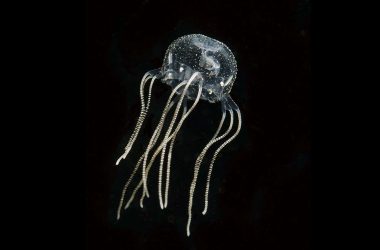An illustration of Kumimanu fordycei (the larger, single bird) and Petradyptes stonehousei penguins on an ancient New Zealand beach
Artwork by Dr. Simone Giovanardi
Penguins come in various sizes, from the fairy penguin (Eudyptula minor) standing at just over 30 centimeters to the 1-meter-tall emperor penguin (Aptenodytes forsteri). However, the mega-penguins that existed millions of years ago make the largest emperors of today appear small in comparison. Let’s take a closer look at these impressive ancient giant penguins.
Kumimanu fordycei
The record for the largest penguin species goes to Kumimanu fordycei, which was first described in February 2023.
Daniel Ksepka at the Bruce Museum in Connecticut and his colleagues discovered an unusually large flipper bone of a penguin in southern New Zealand in 2018. “The big humerus was shocking to me,” Ksepka says. “I almost thought it was maybe some other animal.”
The team quickly determined that it belonged to a new penguin species that lived in what is now New Zealand over 55 million years ago. The size of the bone suggests that the bird probably weighed between 148 and 160 kilograms and stood around 1.6 meters tall. “The emperor penguin just looks like a child next to it,” says Ksepka.
The species was named after paleontologist Ewan Fordyce, who made his own mega-penguin discoveries in the 1970s (see below).
Skeletons of Kumimanu, Petradyptes, and a modern emperor penguin
Artwork by Dr. Simone Giovanardi
Petradyptes stonehousei
Ksepka and his colleagues also discovered another giant penguin called Petradyptes stonehousei alongside K. fordycei. Weighing an estimated 50 kilograms, it was smaller than its contemporary. Its name comes from the Greek words “petra” for rock and “dyptes” for diver, while “stonehousei” was chosen to honor British polar scientist Bernard Stonehouse.
Both K. fordycei and P. stonehousei retained features seen in much earlier penguin species, such as slimmer flipper bones and muscle attachment points resembling those of flying birds.
“Both penguins really add to the case that penguins got their start in New Zealand,” says Ksepka.
Illustration of the extinct Palaeeudyptes klekowskii with a human and emperor penguin for scale
Nature Picture Library / Alamy
Palaeeudyptes klekowskii
Although K. fordycei was the heaviest penguin, it was not the tallest. That distinction belongs to Palaeeudyptes klekowskii, also known as the colossus penguin, which stood at a towering 2 meters and weighed a hefty 115 kilograms.
This species lived along the Antarctic coast 37 to 40 million years ago. Its fossil, including the longest fused ankle-foot bone, is one of the most complete ever found in the Antarctic.
Due to their larger size, giant penguins could stay underwater longer than smaller ones. Experts believe that a species like P. klekowskii could have remained submerged for up to 40 minutes while hunting for fish.
Pachydyptes ponderosus
Pachydyptes ponderosus is a prehistoric giant that lived around 37 to 34 million years ago. Based on the few bones that have been recovered, Ksepka and his colleagues estimated that it stood about 1.5 meters tall and weighed over 100 kilograms.
“We only have parts of the flipper and shoulder, but we think it would have been quite a thick, stocky animal,” says Ksepka. “Its humerus is just so wide.”
Daniel Ksepka with a model of a Kairuku penguin
Daniel Ksepka
Kairuku
On the other hand, the three species belonging to the genus Kairuku (K. grebneffi, K. waitaki, and K. waewaeroa) were quite the opposite.
“If Pachydyptes is like a big, heavy football lineman, then you can think of Kairuku as a really tall, skinny basketball player,” says Ksepka. “They’re both really big, but in different ways.”
The first Kairuku bones were discovered by Ewan Fordyce in the 1970s in New Zealand. These three species lived approximately 34 to 27 million years ago. The tallest among them, K. waewaeroa, stood at around 1.4 meters in height and weighed about 80 kilograms.
“They were graceful penguins, with slender trunks,” says Ksepka.
Topics:












